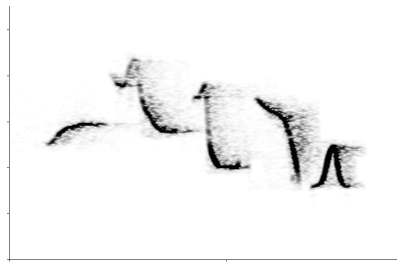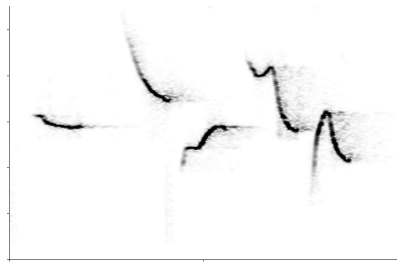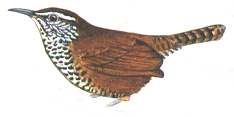

First song in sound file depicted
Click on spectrogram to download sound file
First song in sound file depicted
Click on spectrogram to download sound file

![]()
Song Description:
The Spot-breasted Wren's song consists of rollicking whistled phrases, given singly or in a series. The call bears an uncanny similarity to the sound produced by running your fingernail along a comb.
![]()
Song Measures:
The Spot-breasted Wren's song consists of a phrase of five whistled syllables. These resonant syllables dance up and down within a frequency range of 1600 to 5700 Hz. The initial syllable is usually a flat note of moderate pitch, the next three rise and fall throughout the frequency range, and the terminal syllable, a slightly downslurred note, is usually the lowest. Although Stiles and Skutch (1989) report that phrases may be composed of five to seven syllables, I found only song phrases composed of five syllables in a sample of over 200 songs (>30 from each of five individuals), suggesting that there may be regional dialects in the Spot-breasted Wren's song. Song phrases are, on average, 1.2 ± 0.3 seconds long and may be given singly or in repeats of five (sometimes in repeats of two but rarely in repeats of three).
Like many Thryothorus wrens, Spot-breasted Wrens are known to give very precisely-timed duets. I found only five duets in my recordings (N = 212 songs; sadly all were too distorted to present here), indicating that duets are not common in the non-breeding season. Each of these duets resembled a serial repeat of the typical five-syllable phrase with the duetting partner contributing a three-syllable phrase between the last four syllables of their partner's phrases.
![]()
Singing Behaviour:
Singing birds flit about between perches with remarkable speed in the thick brush at forest edges, but may give long songbouts from a single perch. They cock their tail upwards and may bob it up and down as they sing. Birds respond almost instantly to playback, approaching the playback speaker closely and singing emphatically, suggesting that this wren's song has an important role in territory defense.
It is thought that wren duets are given between paired males and females, perhaps as a means of cementing the "pair bond" or of joint territory defence. It is often suggested that males initiate avian duets. However, only one investigator has sexed duet contributors (in Bay Wrens Thryothorus nigricapillus) and found that the female wren consistently initiates these unusual vocalizations. Hence, we should carefully consider Stiles and Skutch's suggestion that it is the female who interpolates the shorter phrases to Spot-breasted Wren duets.
![]()
Habitat:
Spot-breasted Wrens were heard singing along paths and at village edges in second-growth forest at Nueva Becal and in the Calakmul Biosphere Reserve.
![]()
Return
to Bird Songs of the Yucatan Main Page
All
information and photographs copyright Daniel J. Mennill 1999.
No recordings or other information from this site may be used without
written permission from me.
Please email me (dmennill AT
uwindsor DOT ca) and I will happily grant permission for any
non-commercial or education purposes.